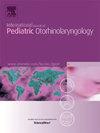Comparison of postoperative bleeding in pediatric tonsillectomy versus tonsillotomy
IF 1.2
4区 医学
Q3 OTORHINOLARYNGOLOGY
International journal of pediatric otorhinolaryngology
Pub Date : 2024-10-08
DOI:10.1016/j.ijporl.2024.112125
引用次数: 0
Abstract
Objective
Tonsillar surgery is a common intervention for pediatric obstructive sleep apnea and recurrent tonsillitis. This study compared postoperative bleeding incidence and severity following tonsillotomy and tonsillectomy at a single medical center.
Study design
A retrospective cohort study on 1984 pediatric patients (1–18 years old) who underwent surgery during 2004–2011 and 2019–2022. Tonsillectomy was performed during 2004–2011, while tonsillotomy was preferred for obstructive sleep apnea during 2019–2022. Tonsillectomy was performed using cold steel technique with complete removal of tonsillar tissue, while tonsillotomy was conducted using mono- or bipolar diathermy, preserving minimal tissue on the tonsillar capsule.
Setting
Shaare-Zedek Medical Center, Faculty of Medicine, Hebrew University.
Methods
Outcome measures included postoperative bleeding incidence and severity, surgery duration, hospitalization length, and readmission.
Results
Tonsillotomy was conducted on 958 (48.3 %) patients, and tonsillectomy was performed on 1026 (51.7 %) patients. Obstructive sleep apnea was the only indication in 1553 (78.3 %) patients. Overall bleeding rate was lower following tonsillotomy (3.9 %) than tonsillectomy (9.5 %) (p < 0.001). Significantly more patients required surgical bleeding control post-tonsillectomy than post-tonsillotomy: 39 (3.7 %) vs. 5 (0.5 %), respectively (p < 0.001). Tonsillectomy resulted in higher readmission rates (11.8 % vs 6.1 %, p < 0.001), more blood transfusions (3 vs. 0), and higher postoperative hemoglobin diminution (1.57 ± 2 vs. 0.94 ± 1 g/dL, p = 0.035). The duration of the surgery was shorter for tonsillotomy (24.7 vs 26.5 min, p = 0.012). Tonsillectomy sustained higher bleeding rates for obstructive sleep apnea patients (7.0 % vs 3.9 %, p = 0.006). For recurrent tonsillitis patients, bleeding rates did not vary between year groups. Older age and tonsillectomy were the most significant risk factors for postoperative bleeding.
Conclusion
Among children undergoing tonsillar surgery for obstructive sleep apnea, tonsillotomy was associated with a safer postoperative bleeding profile, reduced bleeding severity, and fewer readmissions compared to tonsillectomy.
小儿扁桃体切除术与扁桃体切开术术后出血量的比较。
目的:扁桃体手术是治疗小儿阻塞性睡眠呼吸暂停和复发性扁桃体炎的常见方法。本研究比较了一家医疗中心的扁桃体切开术和扁桃体切除术术后出血的发生率和严重程度:一项回顾性队列研究,对象为 2004-2011 年和 2019-2022 年期间接受手术的 1984 名儿科患者(1-18 岁)。2004-2011年期间进行了扁桃体切除术,2019-2022年期间因阻塞性睡眠呼吸暂停首选扁桃体切开术。扁桃体切除术采用冷钢技术,完全切除扁桃体组织,而扁桃体切开术则采用单极或双极透热疗法,保留扁桃体囊上的最小组织:地点:希伯来大学医学院Shaare-Zedek医疗中心:方法:结果测量包括术后出血发生率和严重程度、手术时间、住院时间和再入院情况:958例(48.3%)患者进行了扁桃体切开术,1026例(51.7%)患者进行了扁桃体切除术。阻塞性睡眠呼吸暂停是 1553 例(78.3%)患者的唯一适应症。扁桃体切开术后的总体出血率(3.9%)低于扁桃体切除术(9.5%)(P 结论:扁桃体切开术后的总体出血率(3.9%)低于扁桃体切除术(9.5%):在因阻塞性睡眠呼吸暂停而接受扁桃体手术的儿童中,与扁桃体切除术相比,扁桃体切除术的术后出血情况更安全,出血严重程度更低,再住院率更低。
本文章由计算机程序翻译,如有差异,请以英文原文为准。
求助全文
约1分钟内获得全文
求助全文
来源期刊
CiteScore
3.20
自引率
6.70%
发文量
276
审稿时长
62 days
期刊介绍:
The purpose of the International Journal of Pediatric Otorhinolaryngology is to concentrate and disseminate information concerning prevention, cure and care of otorhinolaryngological disorders in infants and children due to developmental, degenerative, infectious, neoplastic, traumatic, social, psychiatric and economic causes. The Journal provides a medium for clinical and basic contributions in all of the areas of pediatric otorhinolaryngology. This includes medical and surgical otology, bronchoesophagology, laryngology, rhinology, diseases of the head and neck, and disorders of communication, including voice, speech and language disorders.

 求助内容:
求助内容: 应助结果提醒方式:
应助结果提醒方式:


